The 7 best portable bamboo fence installation techniques include quick-install panel systems with pre-drilled holes, no-dig support methods using specialized anchors, roll-out barrier techniques with proper overlapping, freestanding configurations with pebble stabilization, terrain-specific securing with deep support poles, weather-resistant treatments with protective oils, and modular designs for adaptable spaces. You’ll save time with these methods while creating flexible, attractive boundaries that can be reconfigured as needed. The following techniques will transform how you approach temporary fencing solutions.
Quick-Install Bamboo Fence Systems for Temporary Use
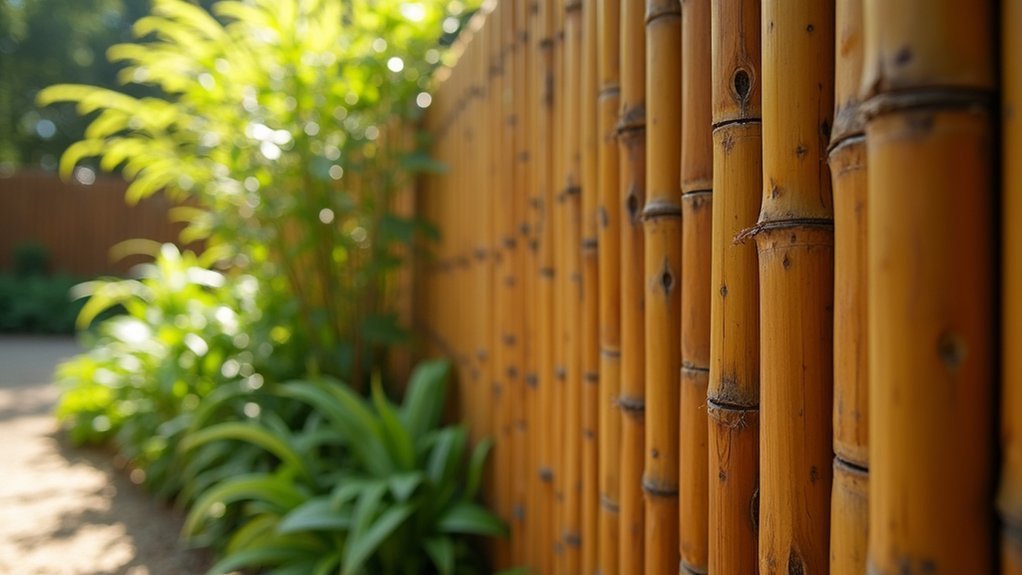
When you need a flexible and immediate fencing solution, quick-install bamboo systems offer exceptional convenience without sacrificing aesthetic appeal. These systems use pre-drilled bamboo panels that dramatically reduce setup time and prevent splitting during assembly.
For installation, secure treated 2×4 horizontal beams as your foundation, anchoring them to soil or existing fences. On cinder block walls, concrete fasteners can secure wooden mounting rails in under an hour. Always use PVC-coated deck screws when attaching panels to wooden frames to prevent rust and guarantee longevity. Cap ends of bamboo poles should always face upward to ensure water damage prevention and maximize the lifespan of your temporary fencing.
The cleverly designed modular panel gaps accommodate uneven terrain or custom layouts without compromising stability. This feature makes these systems particularly valuable for renters or event organizers who need temporary but professional-looking privacy screens that can be easily modified or relocated.
Roll-Out Techniques for Portable Bamboo Barriers
Beyond pre-assembled panels, roll-out bamboo barriers offer another versatile solution for creating temporary boundaries with minimal effort.
When installing these portable systems, lay the barrier parallel to your prepared trench to prevent twists and kinks that could compromise effectiveness.
Lower your HDPE barrier gradually into position, ensuring it protrudes 10-15 cm above the soil surface. Angle the top edge away from the bamboo to naturally guide rhizomes upward for easier maintenance. Proper installation requires a barrier that protrudes at least 100mm above ground to effectively prevent rhizomes from growing over the top.
Position HDPE barriers with a 10-15 cm surface exposure, angling edges to guide rhizomes upward for simplified maintenance.
When joining sections, overlap ends by at least 0.5 meters and secure with Gaffer tape or metal fasteners.
For corners, use stakes to maintain the barrier’s integrity while preventing soil from getting trapped between overlapping layers.
Regular inspection of your portable barrier will help identify any needed adjustments based on soil conditions and growth patterns.
No-Dig Support Methods for Movable Fencing
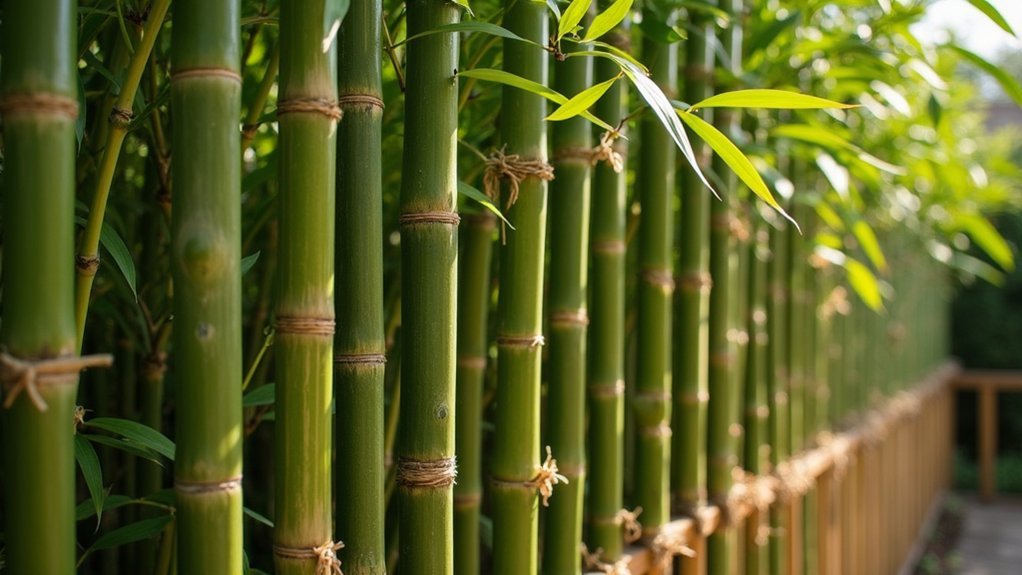
Although traditional bamboo fencing often requires extensive groundwork, no-dig support systems have revolutionized portable barrier installation.
You’ll find these methods particularly advantageous with their DIY-friendly approach and minimal tool requirements.
To install your bamboo fence without digging, you’ll need specially designed posts, support stakes, and anchors that provide stability without disrupting soil. A rubber mallet, sledgehammer, and spirit level are essential tools for proper setup.
Simply drive the posts into the ground using a wood block as a buffer to prevent damage. The entire installation process can typically be completed in a weekend.
These no-dig techniques offer significant benefits: installation takes just hours rather than days, costs remain low without specialized equipment, and your garden’s ecosystem stays intact.
Whether you’re creating a temporary dog enclosure or a decorative garden boundary, this environmentally friendly approach delivers versatility with minimal effort.
Freestanding Bamboo Panel Configurations
Unlike permanent installations, freestanding bamboo panels give you complete flexibility in creating temporary spaces that can be reconfigured whenever you need. Choose from natural, carbonized, or tortoise styles to match your aesthetic preferences, indoors or outdoors.
Remember that stability is essential for these portable structures. Secure your panels by compacting pebbles around the base or adding decorative pots as anchors. For increased mobility, select lightweight, rolled designs or add casters to your screens.
These versatile panels serve dual purposes—providing privacy while enhancing your space with organic beauty. You’ll appreciate how easily they block unsightly areas while complementing your existing décor.
As an eco-friendly, affordable option, bamboo requires minimal installation effort while offering durability and sustainability that other materials can’t match. The panels measuring 4 feet tall can create perfect-height dividers for most residential spaces.
Securing Portable Bamboo Fences in Various Terrains
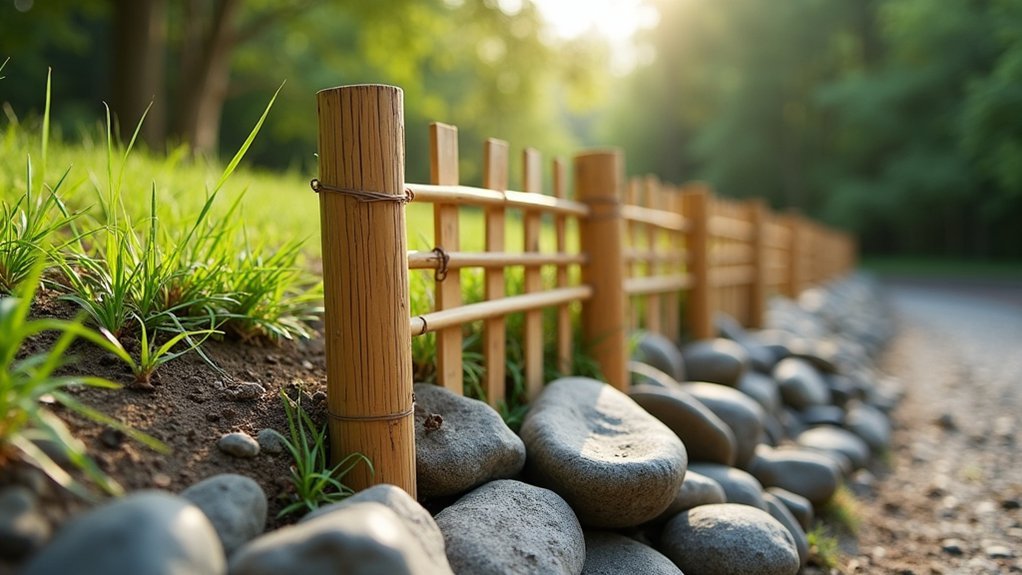
Sandy soil and sloped terrain present unique challenges when installing portable bamboo fencing.
You’ll need to drive support poles at least twice as deep in sandy soil and reinforce them with concrete footings for stability during windy conditions.
For sloped areas, you can step your fence sections to follow the natural terrain or create a level base using adjustable brackets that compensate for the incline. Using bamboo with its high tensile strength ensures your portable fence remains durable even when faced with challenging installation environments.
Sandy Soil Solutions
When installing portable bamboo fences in sandy soil, you’ll face unique challenges that require specialized anchoring techniques. Drive 24-inch ground spikes diagonally for cross-stability, or use water-filled sand anchors that can be repositioned as needed.
Prepare the installation area by lightly misting the sand to improve compaction. For better stability, consider mixing 20-30% bentonite clay with the topsoil layer or installing perimeter gravel trenches 6-8 inches deep to prevent wind erosion. Consider adding wooden bracing supports to reinforce your fence structure against strong winds, similar to techniques used in permanent bamboo fence installations.
Mobile concrete blocks with attachment hooks or sandbags filled with pea gravel provide excellent counterweight along your fence line.
For wind mitigation, choose ripple-style fence weaving that allows 40-50% wind passage or undulating fence lines that break wind force compared to straight runs.
Sloped Terrain Techniques
Moving from flat sandy environments to uneven ground presents different installation challenges altogether.
You’ll need to assess the slope angle first, then select the appropriate installation method—racked or stepped designs work best for bamboo fences on slopes.
For racked installations, allow your bamboo panels to follow the natural contours by securing them at angles.
With stepped approaches, install fence sections at different heights to match terrain changes.
Always dig deeper post holes on slopes and use concrete anchoring for stability. Consider soil stability evaluation to avoid erosion risks that can undermine your bamboo fence’s foundation over time.
V-shaped or diagonal post configurations provide extra support against gravity’s pull.
Use level tools consistently to maintain proper alignment throughout installation.
After setting up, apply waterproof sealants to protect your bamboo fence from increased moisture exposure that often occurs on slopes.
Regular inspections will help identify terrain shifts that may affect your fence’s stability.
Weather-Resistant Treatments for Mobile Bamboo Installations
Creating durable, weather-resistant bamboo fencing requires specific treatments and installation techniques, especially for portable designs that face varied environmental conditions.
While Tonkin bamboo offers natural pest resistance and durability, applying protective coatings greatly extends its lifespan.
Seal your bamboo with clear varnish or weather-resistant oils like tung or linseed oil to prevent moisture absorption. Backyard X-Scapes Products offer pre-treated options that simplify the weatherproofing process. Elevate panels slightly from the ground and use stainless-steel fasteners to maintain structural integrity. Add caps to bamboo poles to prevent water from entering hollow stems.
Maintain your fence by cleaning it regularly and reapplying protective treatments every 1-2 years. During severe weather, store portable sections under cover.
For best results, select mature bamboo with thick culms, as their dense fiber content naturally enhances weather resistance.
Modular Bamboo Fencing for Adaptable Space Division
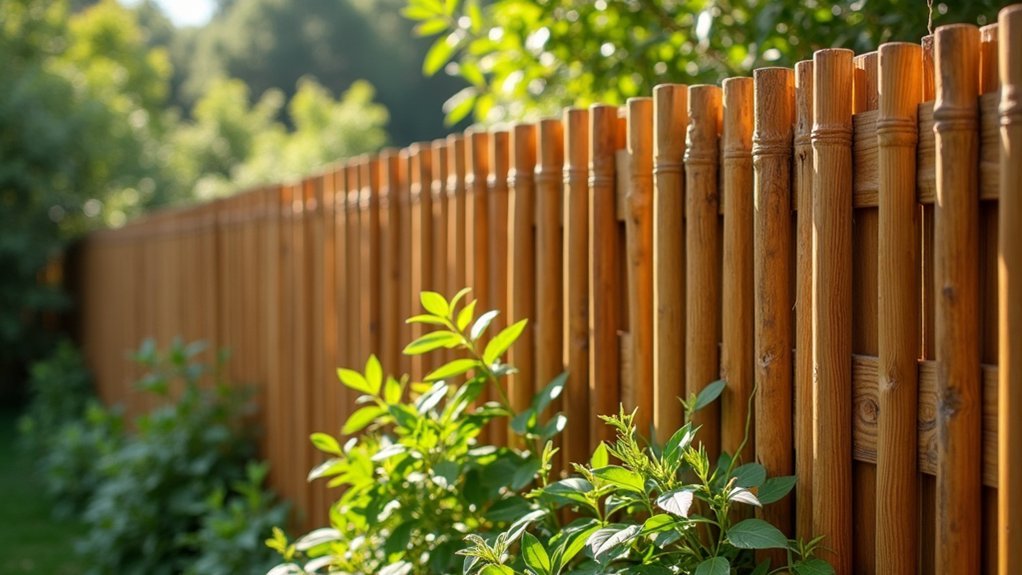
Why struggle with permanent fencing solutions when modular bamboo fencing offers unmatched flexibility for your outdoor spaces? These pre-assembled panels allow you to easily reconfigure your space as needed, whether you’re hosting an event or creating a private nook in your garden.
- Quick assembly – Connect standard-sized panels with minimal tools for installations that don’t require digging.
- Versatile applications – Use indoors as stylish room dividers or outdoors to create secluded areas on patios and balconies.
- Customizable aesthetics – Choose from various woven patterns and complementary materials like river reeds for your desired look.
- Cost-effective privacy – Enjoy affordable, sustainable screening that allows airflow while blocking unwanted views.
You’ll appreciate how these reusable components can be rearranged to adapt to changing needs throughout the seasons. Our bamboo and eucalyptus options are reinforced with concealed galvanized steel for exceptional durability while maintaining a natural appearance.
Frequently Asked Questions
How Long Does Portable Bamboo Fencing Typically Last?
Your portable bamboo fencing typically lasts 2 years untreated, 5-6 years with chemical treatment, and up to 20+ years with proper maintenance. You’ll need regular sealing, staining, and cleaning to maximize its lifespan.
Can Bamboo Fences Withstand Strong Winds Without Permanent Installation?
Yes, your bamboo fence can withstand strong winds without permanent installation if you use reinforcements like stakes, sandbags, or weighted bases, and choose designs with slatted panels that allow wind to pass through.
Is Portable Bamboo Fencing Pet and Child-Safe?
Portable bamboo fencing isn’t inherently pet or child-safe. You’ll need to reinforce it with wire mesh, secure connections, and regular maintenance. Consider adding sturdy frames and anchoring it properly to improve safety for your family.
How Do You Store Bamboo Fence Panels Between Uses?
Store your bamboo fence panels in a dry, climate-controlled area, off the ground. Cover them with breathable fabric, apply sealant for moisture protection, and keep them away from direct sunlight between uses.
Can Portable Bamboo Fencing Be Installed on Decks or Patios?
Yes, you can easily install portable bamboo fencing on both decks and patios. On decks, use deck screws with pre-drilled holes. For patios, attach to wooden supports secured with masonry fasteners to concrete surfaces.
In Summary
Whether you’re creating temporary privacy, dividing garden spaces, or setting up an event boundary, these portable bamboo fence techniques offer flexibility without permanence. You’ll find options for every need, from roll-out barriers to freestanding panels. With proper weather treatment and appropriate securing methods, your portable bamboo fence will provide the perfect solution wherever you need it. Remember, the beauty of portable bamboo lies in its adaptability—use it today, move it tomorrow.

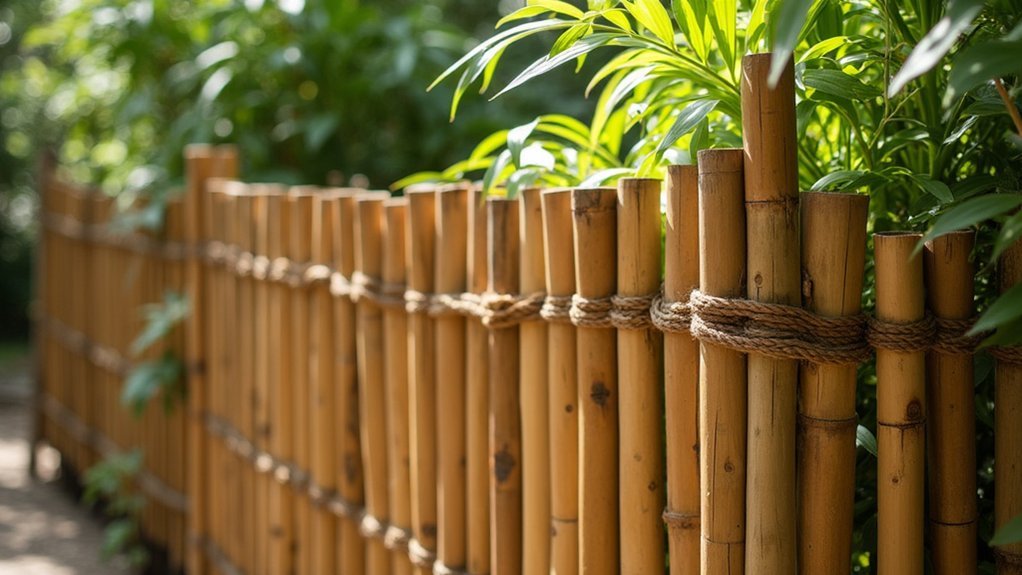



Leave a Reply